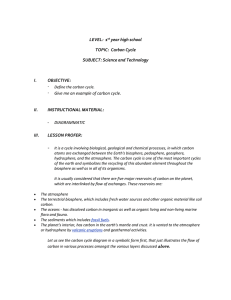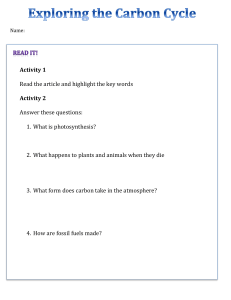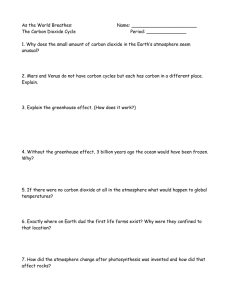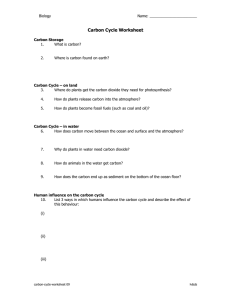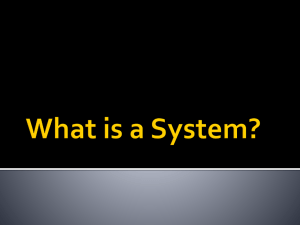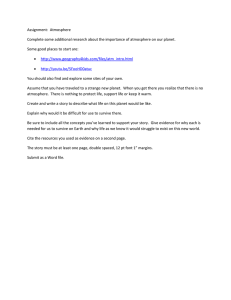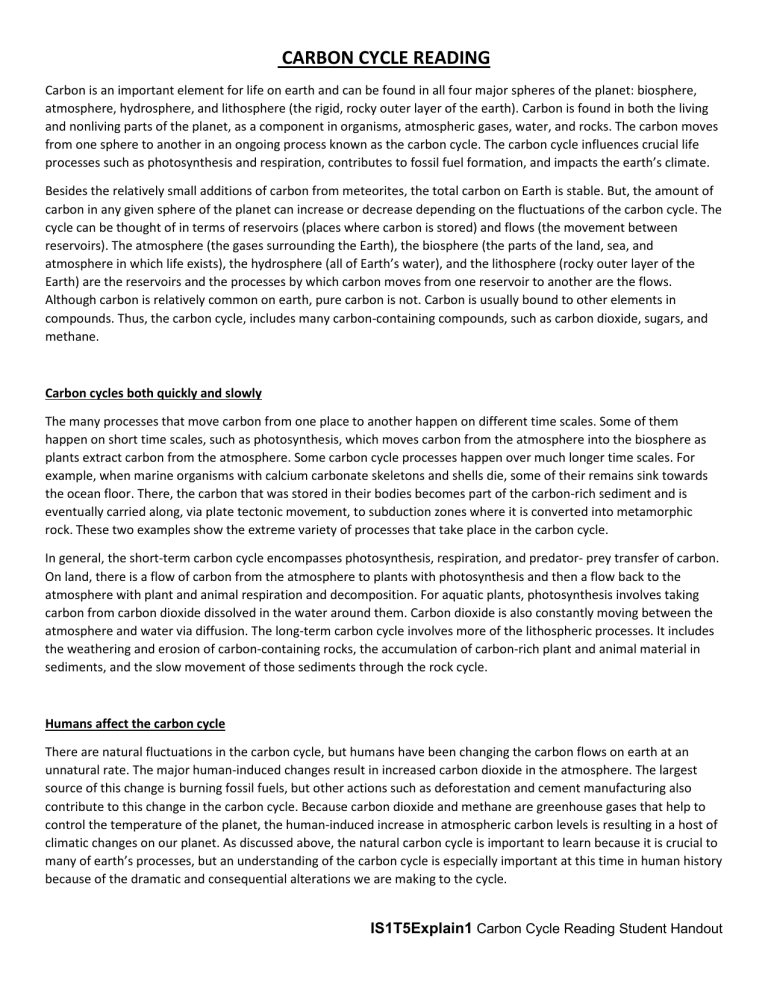
CARBON CYCLE READING Carbon is an important element for life on earth and can be found in all four major spheres of the planet: biosphere, atmosphere, hydrosphere, and lithosphere (the rigid, rocky outer layer of the earth). Carbon is found in both the living and nonliving parts of the planet, as a component in organisms, atmospheric gases, water, and rocks. The carbon moves from one sphere to another in an ongoing process known as the carbon cycle. The carbon cycle influences crucial life processes such as photosynthesis and respiration, contributes to fossil fuel formation, and impacts the earth’s climate. Besides the relatively small additions of carbon from meteorites, the total carbon on Earth is stable. But, the amount of carbon in any given sphere of the planet can increase or decrease depending on the fluctuations of the carbon cycle. The cycle can be thought of in terms of reservoirs (places where carbon is stored) and flows (the movement between reservoirs). The atmosphere (the gases surrounding the Earth), the biosphere (the parts of the land, sea, and atmosphere in which life exists), the hydrosphere (all of Earth’s water), and the lithosphere (rocky outer layer of the Earth) are the reservoirs and the processes by which carbon moves from one reservoir to another are the flows. Although carbon is relatively common on earth, pure carbon is not. Carbon is usually bound to other elements in compounds. Thus, the carbon cycle, includes many carbon-containing compounds, such as carbon dioxide, sugars, and methane. Carbon cycles both quickly and slowly The many processes that move carbon from one place to another happen on different time scales. Some of them happen on short time scales, such as photosynthesis, which moves carbon from the atmosphere into the biosphere as plants extract carbon from the atmosphere. Some carbon cycle processes happen over much longer time scales. For example, when marine organisms with calcium carbonate skeletons and shells die, some of their remains sink towards the ocean floor. There, the carbon that was stored in their bodies becomes part of the carbon-rich sediment and is eventually carried along, via plate tectonic movement, to subduction zones where it is converted into metamorphic rock. These two examples show the extreme variety of processes that take place in the carbon cycle. In general, the short-term carbon cycle encompasses photosynthesis, respiration, and predator- prey transfer of carbon. On land, there is a flow of carbon from the atmosphere to plants with photosynthesis and then a flow back to the atmosphere with plant and animal respiration and decomposition. For aquatic plants, photosynthesis involves taking carbon from carbon dioxide dissolved in the water around them. Carbon dioxide is also constantly moving between the atmosphere and water via diffusion. The long-term carbon cycle involves more of the lithospheric processes. It includes the weathering and erosion of carbon-containing rocks, the accumulation of carbon-rich plant and animal material in sediments, and the slow movement of those sediments through the rock cycle. Humans affect the carbon cycle There are natural fluctuations in the carbon cycle, but humans have been changing the carbon flows on earth at an unnatural rate. The major human-induced changes result in increased carbon dioxide in the atmosphere. The largest source of this change is burning fossil fuels, but other actions such as deforestation and cement manufacturing also contribute to this change in the carbon cycle. Because carbon dioxide and methane are greenhouse gases that help to control the temperature of the planet, the human-induced increase in atmospheric carbon levels is resulting in a host of climatic changes on our planet. As discussed above, the natural carbon cycle is important to learn because it is crucial to many of earth’s processes, but an understanding of the carbon cycle is especially important at this time in human history because of the dramatic and consequential alterations we are making to the cycle. IS1T5Explain1 Carbon Cycle Reading Student Handout Questions and Analysis: 1) List the processes that were mentioned in the reading that contribute to moving carbon through the carbon cycle: _______________________________________________________________________________________________ _______________________________________________________________________________________________ _______________________________________________________________________________________________ 2) Why is this statement false? “The amount of carbon on our entire planet can increase or decrease depending on the fluctuations of the carbon cycle.” _______________________________________________________________________________________________ _______________________________________________________________________________________________ _______________________________________________________________________________________________ _______________________________________________________________________________________________ 3) What processes are involved in the “short-term” carbon cycles? _______________________________________________________________________________________________ ______________________________________________________________________________________________ 4) How does photosynthesis move carbon? _____________________________________________________________ _______________________________________________________________________________________________ _______________________________________________________________________________________________ 5) What processes are involved in the “long-term” carbon cycles? ___________________________________________ _______________________________________________________________________________________________ 6) List some human actions that have been affecting the carbon cycle: _____________________________________________________________________________________________ 7) Explain how humans, the carbon cycle, and global warming are connected. _______________________________________________________________________________________________ _______________________________________________________________________________________________ _______________________________________________________________________________________________ IS1T5Explain1 Carbon Cycle Reading Student Handout
